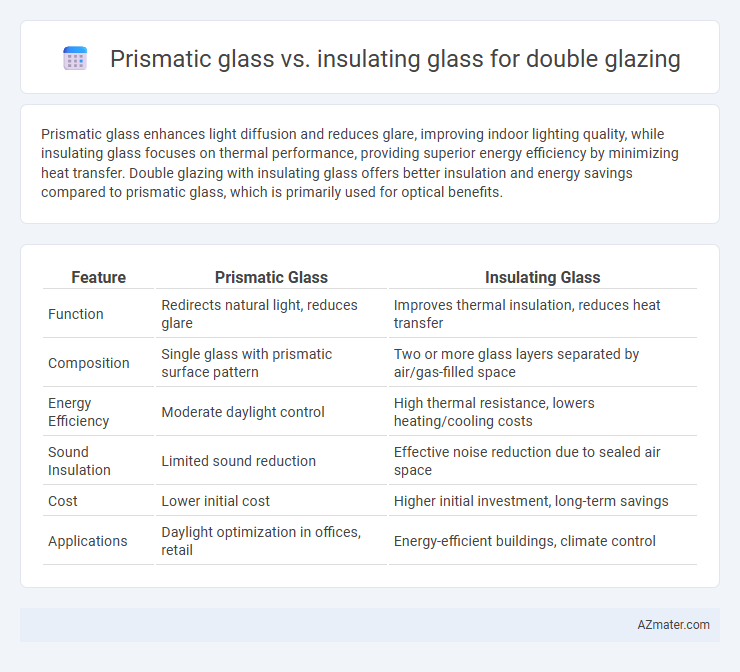Prismatic glass enhances light diffusion and reduces glare, improving indoor lighting quality, while insulating glass focuses on thermal performance, providing superior energy efficiency by minimizing heat transfer. Double glazing with insulating glass offers better insulation and energy savings compared to prismatic glass, which is primarily used for optical benefits.
Table of Comparison
| Feature | Prismatic Glass | Insulating Glass |
|---|---|---|
| Function | Redirects natural light, reduces glare | Improves thermal insulation, reduces heat transfer |
| Composition | Single glass with prismatic surface pattern | Two or more glass layers separated by air/gas-filled space |
| Energy Efficiency | Moderate daylight control | High thermal resistance, lowers heating/cooling costs |
| Sound Insulation | Limited sound reduction | Effective noise reduction due to sealed air space |
| Cost | Lower initial cost | Higher initial investment, long-term savings |
| Applications | Daylight optimization in offices, retail | Energy-efficient buildings, climate control |
Introduction to Double Glazing Technologies
Double glazing technologies utilize two glass panes separated by a spacer, enhancing thermal insulation and noise reduction compared to single glazing. Prismatic glass introduces light diffusion and improves daylight distribution inside buildings, while insulating glass units typically employ inert gas fills and low-emissivity coatings to reduce heat transfer. Selecting between prismatic and insulating glass depends on the desired balance of energy efficiency, natural lighting, and visual comfort in architectural applications.
Overview of Prismatic Glass
Prismatic glass enhances double glazing by incorporating micro-structured surfaces that refract and diffuse natural light, improving daylight distribution and reducing glare within interior spaces. Unlike standard insulating glass, prismatic glass maintains thermal insulation properties while optimizing light control for energy-efficient building design. Its unique optical technology offers a balance between energy savings and visual comfort, making it an innovative alternative to traditional double glazing solutions.
Overview of Insulating Glass
Insulating glass, also known as double glazing, consists of two or more glass panes separated by a sealed air or gas-filled space to reduce heat transfer and enhance energy efficiency in buildings. It significantly improves thermal insulation, reduces noise pollution, and minimizes condensation compared to prismatic glass, which primarily focuses on light diffusion and aesthetic effects. The airtight seal and gas fill in insulating glass units optimize thermal performance, making them ideal for maintaining comfortable indoor temperatures and reducing heating and cooling costs.
Key Differences Between Prismatic and Insulating Glass
Prismatic glass utilizes a patterned surface to refract light, enhancing daylight distribution and reducing glare, whereas insulating glass consists of multiple glass panes separated by a sealed air or gas-filled space to improve thermal insulation. Prismatic glass primarily focuses on optical performance and visual comfort, while insulating glass emphasizes energy efficiency by minimizing heat transfer. The choice between the two depends on whether the priority is enhanced natural lighting effects or superior thermal insulation in double-glazed windows.
Energy Efficiency Comparison
Prismatic glass enhances energy efficiency by redirecting sunlight deeper into interiors, reducing the need for artificial lighting and lowering heating costs through passive solar gain. Insulating glass, often composed of multiple panes separated by gas-filled spaces, minimizes heat transfer, providing superior thermal insulation and reducing heating and cooling energy consumption. When comparing energy efficiency, insulating glass generally offers better overall thermal resistance, while prismatic glass optimizes daylighting to complement heating and lighting energy savings.
Daylighting and Light Diffusion Performance
Prismatic glass enhances daylighting by redirecting sunlight deeper into interior spaces, improving natural light distribution and reducing glare compared to traditional insulating glass. Insulating glass focuses on thermal efficiency but offers limited light diffusion, often resulting in uneven daylighting and hotspots near windows. For optimal daylighting and uniform light diffusion, prismatic glass significantly outperforms insulating glass by maximizing natural light penetration while maintaining visual comfort.
Thermal and Acoustic Insulation Capabilities
Prismatic glass enhances natural light diffusion while offering moderate thermal insulation by reducing heat transfer through its angular design, but it generally falls short in acoustic insulation compared to insulating glass. Insulating glass, typically composed of two or more glass panes separated by an air or gas-filled spacer, significantly improves thermal performance by minimizing heat loss and gain, and provides superior soundproofing due to its multilayer structure. For double glazing applications focused on energy efficiency and noise reduction, insulating glass outperforms prismatic glass in both thermal and acoustic insulation capabilities.
Design Flexibility and Aesthetics
Prismatic glass enhances design flexibility and aesthetics in double glazing by manipulating light through geometric patterns, offering unique visual effects and reducing glare without compromising transparency. Insulating glass focuses on energy efficiency and thermal performance, often incorporating clear or low-emissivity coatings that maintain a minimalist appearance but limit decorative options. Choosing prismatic glass allows architects to integrate artistic elements and dynamic lighting into facades, while insulating glass prioritizes functional clarity and temperature control in contemporary designs.
Cost and Installation Considerations
Prismatic glass typically costs more than standard insulating glass due to its specialized light-diffusing properties and manufacturing complexity, influencing overall budget allocation for double glazing projects. Installation of prismatic glass may require more precise handling and expert technicians to maintain the integrity of its optical features, which can increase labor costs and time. Insulating glass, commonly used in double glazing, offers more straightforward installation processes and generally lower costs, making it a preferred choice for budget-conscious consumers prioritizing thermal performance over advanced light control.
Choosing the Best Glass Type for Your Double Glazing Needs
Prismatic glass in double glazing enhances natural light diffusion while reducing glare, making it ideal for spaces requiring balanced brightness and privacy. Insulating glass, consisting of multiple panes separated by a gas-filled cavity, excels in thermal performance and energy efficiency, minimizing heat transfer and reducing energy costs. Choosing between prismatic and insulating glass depends on prioritizing light management versus thermal insulation for your specific double glazing needs.

Infographic: Prismatic glass vs Insulating glass for Double glazing
 azmater.com
azmater.com